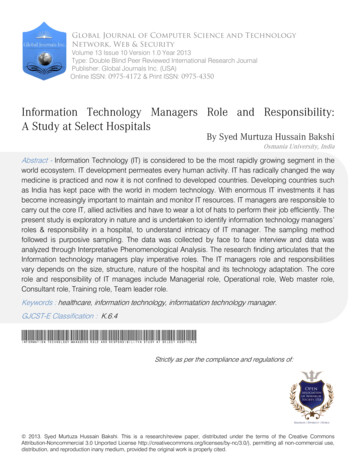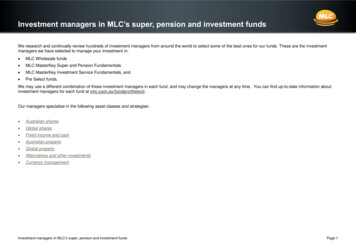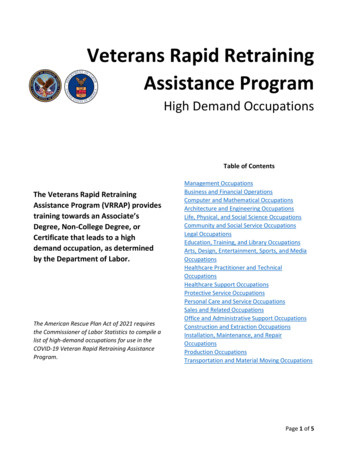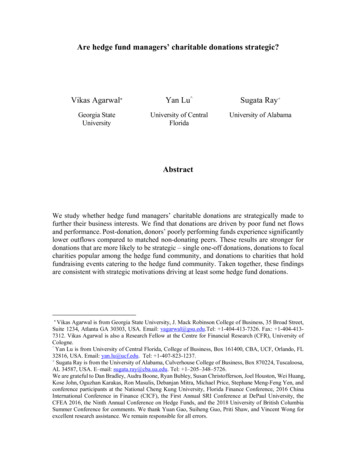
Transcription
Global Journal of Computer Science and TechnologyNetwork, Web & SecurityVolume 13 Issue 10 Version 1.0 Year 2013Type: Double Blind Peer Reviewed International Research JournalPublisher: Global Journals Inc. (USA)Online ISSN: 0975-4172 & Print ISSN: 0975-4350Information Technology Managers Role and Responsibility:A Study at Select HospitalsBy Syed Murtuza Hussain BakshiOsmania University, IndiaAbstract - Information Technology (IT) is considered to be the most rapidly growing segment in theworld ecosystem. IT development permeates every human activity. IT has radically changed the waymedicine is practiced and now it is not confined to developed countries. Developing countries suchas India has kept pace with the world in modern technology. With enormous IT investments it hasbecome increasingly important to maintain and monitor IT resources. IT managers are responsible tocarry out the core IT, allied activities and have to wear a lot of hats to perform their job efficiently. Thepresent study is exploratory in nature and is undertaken to identify information technology managers’roles & responsibility in a hospital, to understand intricacy of IT manager. The sampling methodfollowed is purposive sampling. The data was collected by face to face interview and data wasanalyzed through Interpretative Phenomenological Analysis. The research finding articulates that theInformation technology managers play imperative roles. The IT managers role and responsibilitiesvary depends on the size, structure, nature of the hospital and its technology adaptation. The corerole and responsibility of IT manages include Managerial role, Operational role, Web master role,Consultant role, Training role, Team leader role.Keywords : healthcare, information technology, informatation technology manager.GJCST-E Classification : K.6.4Information Technology Managers Role and ResponsibilityA Study at Select HospitalsStrictly as per the compliance and regulations of: 2013. Syed Murtuza Hussain Bakshi. This is a research/review paper, distributed under the terms of the Creative CommonsAttribution-Noncommercial 3.0 Unported License http://creativecommons.org/licenses/by-nc/3.0/), permitting all non-commercial use,distribution, and reproduction inany medium, provided the original work is properly cited.
Information Technology Managers Role andResponsibility: A Study at Select Hospitalsmost rapidly growing segment in the world ecosystem. ITdevelopment permeates every human activity. IT has radicallychanged the way medicine is practiced and now it is notconfined to developed countries. Developing countries suchas India has kept pace with the world in modern technology.With enormous IT investments it has become increasinglyimportant to maintain and monitor IT resources. IT managersare responsible to carry out the core IT, allied activities andhave to wear a lot of hats to perform their job efficiently. Thepresent study is exploratory in nature and is undertaken toidentify information technology managers’ roles &responsibility in a hospital, to understand intricacy of ITmanager. The sampling method followed is purposivesampling. The data was collected by face to face interview anddata was analyzed through Interpretative PhenomenologicalAnalysis. The research finding articulates that the Informationtechnology managers play imperative roles. The IT managersrole and responsibilities vary depends on the size, structure,nature of the hospital and its technology adaptation. The corerole and responsibility of IT manages include Managerial role,Operational role, Web master role, Consultant role, Trainingrole, Team leader role.Keywords : healthcare, information technology, informatation technology manager.II.Introductionnformation and communication technology paraphernalia are arguably the most rapidly growingsegment of the world ecosystem. The development inthe sector permeates every human activity; social,economic, cultural, religious, political and healthcare(Idowu P et al, 2008). Information technology hasradically changed the way that many people employed,work and think. Over the years, technology has toucheda new pinnacle and now it is not confined to developedcountries. Developing countries such as India have keptpace with the world in modern technology. Informationtechnology has revolutionized the way medicine ispracticed and how healthcare information is documented, archived and retrieved at the point of care.Healthcare professionals can no longer ignorethe practical application of information technology. Whileinformation technology is facing challenges of adoption,communication technology is striving to create healthinformation exchanges for connecting providers withinmulti-organization environments and across disparateAuthor : Vice Principal and Associate Professor, Department ofHospital Management, Owaisi Hospital and Research Center,Hyderabad, 500058. E-mail : murtuzain21@gmail.comgeographical boundaries, using secure and fail-safeinternet connectivity for high speed data, voice andvideo communication (Neeraj Gour & Dhiraj Srivastava,2010, Dr. Ajit K. Nagpal, 2011 ).With enormous investments and intervention ofInformation Technology, IT has become increasinglyimportant. Organizations continue to understand thebenefits from IT especially in conjunction with corporateinitiatives such as business process reengineering(BPR). Furthermore, the impact of technology on nonfinancial outcomes such as customer satisfaction andquality is gaining interest. (Sarv Devaraj & Rajiv Kohli,2000). In order to manage IT related product and serviceIT manager has to wear a lot of hats. Different part oforganization will have different expectations of thisposition which has to be matched. (Bill Holtsnider andBrian D. Jaffe, 2012). It is also held that to be aneffective IT manager he should develop a border frameof references, admit information you might otherwiseignore and consider other professional viewpoint (RobAalders and Peter Hind, 2002)II.MethodsThe present study is exploratory in nature. Thedata is largely descriptive and categorized as a nonexperimental qualitative study. The research isundertaken to identify information technology manager’sroles & responsibility in a hospital and to understandintricacy allied with the job. The sampling methodfollowed is purposive sampling. A prior appointmentwas taken from 45 participants including senior ITmanagers and junior IT managers who were working atleast for one year with the hospital and were full timeemployees. They were briefed about the research studyand encouraged to expel information relating to role andresponsibilities as an IT manager .The data wascollected by face to face interview; the facts wererecorded manually. After the recording from the entire45 participants data was analyzed through InterpretativePhenomenological Analysis. The study is restricted tohospitals of Hyderabad and Secunderabad.III.DiscussionsThe research finding articulates that theInformation technology managers play imperative roles.The IT managers role and responsibilities vary dependson the size, structure, nature of the hospital and its 2013 Global Journals Inc. (US)29Global Journal of Computer Science and Technology ( DE ) Volume XIII Issue X Version IAbstract - Information Technology (IT) is considered to be theYear 2 013Syed Murtuza Hussain Bakshi
Information Technology Managers Role and Responsibility:- A Study at Select Hospitalstechnology adaptation. It was evident from the researchthat the IT managers are supported with full team thatincluded a junior IT manager with skilled assistance anddomain experts. The primary or core IT managers rolesand responsibilities that were expressed after the studyare represented in the form of sketch.Figure 1 : Role and Responsibilities of IT ManagerYear 2 0131. Managerialrole8. Backup andsecuritymanager role2. OperationalroleGlobal Journal of Computer Science and Technology ( DE ) Volume XIII Issue X Version I307. Vendormanagementrole3. Web masterroleHealthcare ITmanagersRole andResponsibilities4. Consultantrole6. Team leaderrole5. Trainingrolea) Managerial Role Supervision and development of ideal IT systemwith staffing the IT team.Create an IT roadmap and action plan for dministration and monitor major projects, ITbudgets, priorities, standards, procedures, andoverall IT performance.Involve in testing integrity and performance ofvarious information networks and softwareapplications.Regular Periodic review and evaluate how currentsystems and applications are meeting the needs ofthe hospital and employees working. Coordinatewith all head of the departments within hospital andtake their inputs to improve the technologysolutions, implementation and adoption. 2013 Global Journals Inc. (US) Regular review meetings with all the key stakeholders to update on IT actions. Review theadequacy and allocation of IT resources in terms offunding, personnel, equipment, and service levels.Researching and installing new and improvedsystems.Control the computer systems budgets andexpenditures.b) Operational Role IT Manager is responsible for managing the end-toend IT operations of the hospitals. That includePlan, organize, direct, control and evaluate theoperations of information systems and electronicprocessing.Provide network design, installation, monitoring,management, and troubleshooting for WAN andLANs including main locations and remote sites. If
Information Technology Managers Role and Responsibility:- A Study at Select Hospitals c) Web Master Role IT manager’s role includes E-business planning,particularly in terms of defining the Internetpresence of a hospital with all latest informationalupdates and web support.Higher backend E- process and responsibilitiesrange from encrypting , tracking informationcollected from visitors visiting the sites ( MedicalTourism), developing and monitoring onlinecommunity tools (social networking), such asmessage boards, feedback forms, surveys,software and hardware related to Internet.d) Consultant Role IT managers also serve as consultants to executivelevel officers when it comes to developing andapplying information technology policy andstandards.IT manager’s coordinates with system analysts,computer programmers, developers, support staffand assign priorities during in house softwaredevelopment process.IT manager identifies, communicates andimplement new technologies to enhance the longterm operational and strategic goals of the hospital.e) Training Role Train staff about new and potential use of thesystem.Provide orientation to new users of implementedtechnology.Providing User Training on various businessapplications and application software.Provide individual training and support on request.f)Team Leader Role Leads the IT team at the Hospital which comprisesof the hardware, networking, software and databasespecialists.Manage the requirement of various specialists andharmonious functioning of the IT team. Approve and handle IT vendors used by theorganization, AMC, Support agreements, Reviewmeetings.Obtaining competitive prices from suppliers, toensure cost effectiveness.Ensuring that software licensing laws are adheredto.h) Backup and Security Manager Role Scheduling upgrades and security backups ofhardware and software systems.Troubleshoot all technology issues.Maintain log and/or list of required repairs andmaintenance.Provide network accounts and passwords asrequired.Identify and prepare hardware for disposal whenappropriate.Ensure hardware is stripped and secured beforedisposal.IV.List of AbbreviationsAMC : Annual Maintenance ContractE- Process : Electronic ProcessHIS : Hospital Information SystemIS : Information SystemsIT : Information TechnologyWAN : Wide Area NetworkLAN : Local Area NetworkReferences Références Referencias1. Bill Holtsnider, Brian D. Jaffe, (2012), IT Manager'sHandbook: Getting your new job done, third edition,U.S.A, Elsevier.2. Gorden, s.1993. Standardization of informationsystem and technology at multinational companiesJ. Global inform, management 1(3) 5-14.3. Idowu P., Cornford D., Bastin L. (2008). Healthinformatics deployment in Nigeria. Journal of HealthInformatics in Developing Countries, 2(1), 15-23.4. Jeanne W. Ross & Peter Weill. 2002, Six ITdecisions your IT people shouldn’t make, HarvardBusiness Review, pp 2-10.5. Keen, P.G.W.1991. Shaping the future, HarvardBusiness School Press, Boston, MA.6. National IT Backbone for Healthcare by Dr. Ajit K.Nagpal Chairman Executive Council, Batra Hospital& Medical Research Center, New -details.asp [Accessed 24/01/12].7. Neeraj Gour, Dhiraj Srivastava (2010). Knowledge ofComputer among Healthcare Professionals of India:A Key toward e-Health. Telemedicine and e-Health,16(9): 957-962. 2013 Global Journals Inc. (US)Year 2 013 g) Vendor Management Role31Global Journal of Computer Science and Technology ( DE ) Volume XIII Issue X Version I needed Provide networking support to partnerorganizations.Ensures successful implementation and rollout ofvarious modules of the Hospital ManagementSystem at the hospital. Setup and manage helpdesk support for staff within the ance.Valuating user needs and system functionality andensuring the facilities meet these needs i.e.Coordinate priorities between the IT department anduser departments.Maintain current and accurate inventory oftechnology hardware, software and resources.
Year 2 013Information Technology Managers Role and Responsibility:- A Study at Select Hospitals8. Rob Aalders, Peter Hind (2002), The IT Manager'sSurvival Guide, England, john Wiley & sons, Ltd.9. Sarv Devaraj and Rajiv Kohli, InformationTechnology Payoff in the Health-Care Industry: ALongitudinal Study, Journal of ManagementInformatio Systems Vol. 16, No. 4, (Spring, 2000),pp. 41-67.10. Weill. P, M.Broadbent.1998, leveraging the newinfrastructure: how market leaders capitalize oninformation technology, Harvard business schoolpress, Cambridge, MA.Global Journal of Computer Science and Technology ( DE ) Volume XIII Issue X Version I32 2013 Global Journals Inc. (US)
4. Consultant 3. Web master role 2. Operational role 1. Managerial role Healthcare IT managers Role and Responsibilities Control the computer systems budgets and expenditures. b) Operational Role IT Manager is responsible for managing the end-to end IT operations of the hospitals. That include ystems and electronic processing.










